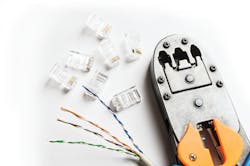Although cable of all types tends to be overshadowed by other, more “glamorous”, technologies, they are nevertheless essential elements in just about any security system. One of cable’s most important components is the shielding that keeps stray electrical and radio-frequency signals outside and signals running through the cables inside.
In many applications, shielding is not an option but a mandatory requirement. Since there are several shielding types, it is important to understand the applications for which each one is best suited.
Shielded cable was once chosen only for the most obvious, horrendously noisy environments; however, today that description applies to more places than ever – even supposedly benign environments such as plenums where cables remain largely forgotten for years.
The types of shielding for various types of cables have not changed much over the years – what has changed is the effectiveness of shielded cables, which has continually improved year after year. Although there is no such thing as a perfectly-shielded cable, the amount of attenuation that can now be achieved is so high that what interference remains should not degrade performance.
Types and Sources of Interference
The electromagnetic spectrum is a crowded place, especially between DC and about 6 GHz. The spectrum chart below is basically impossible to read – not just because in this case it is so small, but also because every bit of it is allocated for a service or services.
Interference sources fall into two broad categories: Electromagnetic Interference (EMI) and Radio Frequency Interference (RFI). Although the two are essentially the same thing, what differentiates them are the frequencies at which they appear. EMI is essentially “electrical noise” occurring at low frequencies while RFI is associated with higher frequencies.
EMI is emitted by electrical devices including generators, motors, transformers, relays, power lines, medical equipment, some forms of lightning, as well as power supplies and innumerable other devices. RFI is typically produced by radio and television broadcast, wireless communications, and other equipment that either transmits an electromagnetic signal or uses RF energy for purposes such as industrial applications, where it is used to generate heat.
The primary medical systems that employ RF and or microwave technology are diathermy machines, ablation systems, and Magnetic Residence Imaging (MRI) – the latter to create an intense magnetic field. Spurious and harmonic signals from these sources – although weaker than their fundamental (i.e. intentional) signal – also cause interference.
EMI and RFI can be either conducted or radiated. When conducted, the unwanted signal appears on a conductor along with the desired signals, while radiated emissions propagate in free space and are picked up by the conductors.
The third type of interference falls into the category of RFI – the unintentional results from a phenomenon called passive intermodulation distortion (PIM). PIM is caused by nonlinearities in the passive components of a wireless system when two signals mix to produce other signals near the desired signal, causing interference. It is caused by rust, aging, corrosion, loose connections, dirt, oxidation – alone or in combination – and it is very difficult to find its source.
PIM has long been a major problem on navy ships where there are numerous high-power emitters but can occur anywhere two high-power signals are present. However, it also occurs at broadcast and wireless installations, so unrelated cabling installed near (or even relatively near) it can be affected. There are ways to remedy this but are the responsibility of the organization responsible for them, if it can be found.
The Effect on Security Systems
Unfortunately, security systems of all types are often located where EMI and RFI occur. Cables such as Cat5 and Cat6 Ethernet can run dozens or hundreds of feet, so there is ample chance for interference.
Security systems are highly susceptible to interference as they must communicate video or audio streams over cables.
The transition from analog to digital transmission and the use of properly-installed shielded cable have somewhat mitigated the interference problem, but even with the best cables and connectors, resistance to EMI and RFI is only as effective as the quality of the installation. Improper installation and inattention to grounding can render any shielding solution ineffective – both of which are unfortunately very common.
Types of Cable Shields
A shield acts in two ways: It can reflect energy and keep it from reaching the conductors; or the interfering signals can be captured “over the air” by the shield and passed to ground. Regardless, to work properly, the shielding and its termination must provide a low-resistance path to ground.
As any discontinuities can increase resistance and thus lower shielding effectiveness, it is one of the reasons why foil-shielded cable is the least effective and most likely to be damaged. That said, various degrees of armoring around the cable can reduce the potential for damage, but they also significantly increase cost, weight and reduce flexibility.
There are two basic types of shielding – foil and braid – that can be used either alone or together. Various cable manufacturers (including L-com) have developed proprietary solutions based on these two types, along with unique cable construction techniques to optimize performance.
Foil shielding utilizes a thin aluminum sheet (like aluminum foil) laminated to a polypropylene or polyethylene carrier that increases its overall strength and reliability. Because of their small size, foil shields are commonly used to protect individual pairs of multi-pair cables to reduce crosstalk. Foil provides 360-degree coverage around the conductors and is the least expensive and lightest alternative. However, it also provides the least shielding effectiveness, has high resistance that offers a relatively poor path to ground, can break in cables exposed to frequent or severe flexing, and is difficult to mate with connectors. The latter is annoying enough that rather than attempting to connect the entire foil to a connector, a wire is often connected to the end of the foil and then to ground.
Braid is a woven mesh of bare or tinned copper wires and typically covers 60 to 85 percent of the conductor area, depending on how tightly the braid is woven. In contrast to foil, braid provides a highly-desirable, low-resistance path to ground and is far easier to terminate to a connector through soldering or crimping. As the braid is copper, it has much higher conductivity than aluminum and also more “substance” – which together provide greater shielding effectiveness.
Braid shields have greater structural integrity while also remaining flexible, and can withstand a fairly rigorous flexing environment. They attenuate both electrical and RF interference and are well suited for interference-sensitive audio applications.
The third category combines foil over the conductors with braid over the top of that, which provides 100-percent coverage and the highest level of shielding effectiveness over the broadest range of frequencies.
Still other combinations for use in the most problematic environments include two levels of braid – a layer of foil, layer of braid, and layer of foil, and even foil covered by braid, covered by foil and another level of braid. Not surprisingly, the cost and weight of these solutions increase with their shielding effectiveness, so it is necessary to decide what level of shielding is actually needed, and in some cases whether the increased weight can be accommodated.
Determining precisely what level of shielding is required is sometimes difficult, as a cable can pass through several areas – each with a different level of potential interference. The best way to evaluate the electromagnetic conditions in a specific place is with a broadband portable spectrum analyzer that graphically depicts how congested the electromagnetic environment is, as well as the amplitude of the signals.
Regardless, working with a technical representative from a preferred cable manufacturer is a wise choice.
The Importance of Grounding
Another issue is proper grounding – the lack of which can negate the improvements afforded by any type of shielded cable. The word “ground” has been misconstrued so often that even some textbooks do not cover it accurately.
Just because a conductor or any other component is connected to something supposedly “grounded” does not mean that it is achieved effectively. This is because in an ideal sense, only a conductor directly and thoroughly connected to an “earth” ground is the most effectively grounded – and even then, soil conditions affect just how thorough the ground is.
In practice, make sure the equipment that the cable is connected to is properly grounded to something that is actually earth-grounded or ideally directly to an earth ground, although this is often impossible. Check to see is the connection between the ground point and the equipment has as very low-resistance path, as this is essential to ensure the best performance.
Dustin Guttadauro is a product manager for Ethernet cabling infrastructure products and fiber optics for L-com Global Connectivity. Request more info about the company at www.securityinfowatch.com/10841325.



